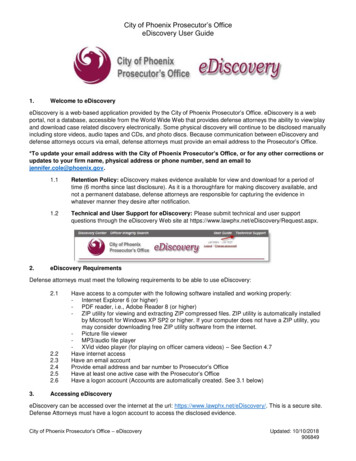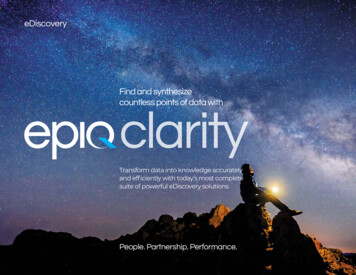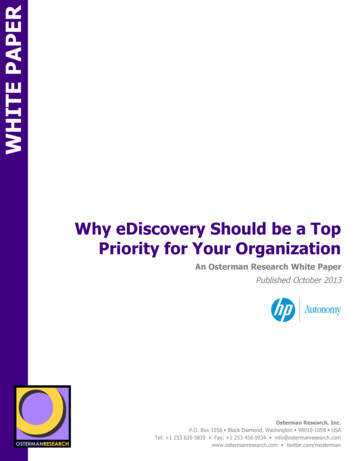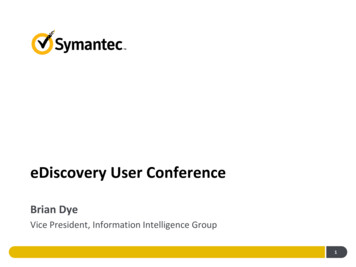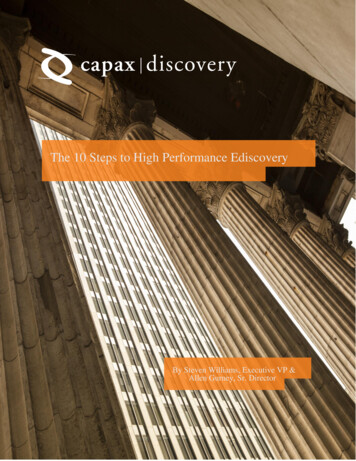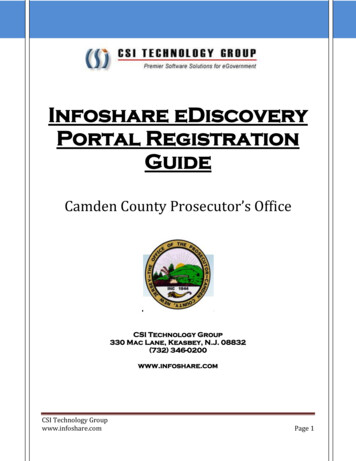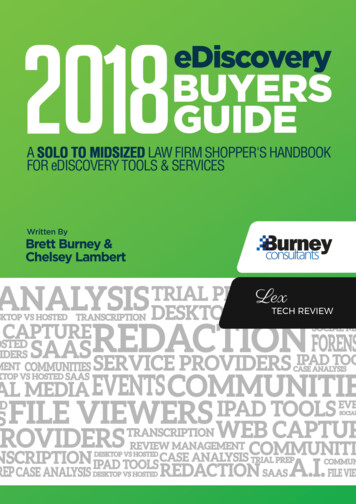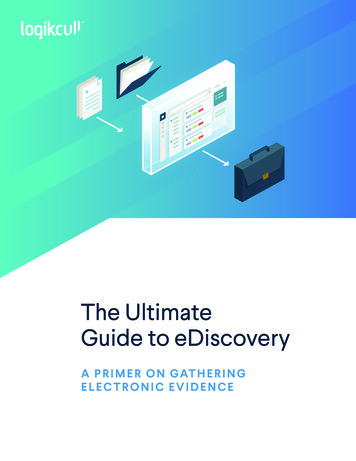
Transcription
The UltimateGuide to eDiscoveryA P R I M E R O N GAT H E R I N GELECTRONIC EVIDENCEThe Ultimate Guide to eDiscoveryPage 1 of 132
ContentsPages 3-28CHAPTER 1An Introduction to Electronic DiscoveryPages 29-53C H A P T E R T WOData Preservation and Legal HoldsPages 54-64CHAPTER THREEInformation GovernancePages 65-82CHAPTER FOUREarly Case AssessmentPages 83-98CHAPTER FIVEDocument ReviewPages 99-114CHAPTER SIXPredictive CodingPages 115-131CHAPTER SEVENDiscovery SoftwareThe Ultimate Guide to eDiscoveryPage 2 of 132
CHAPTER 1An Introduction toElectronic DiscoveryThis chapter describes and defines electronic discovery, or “eDiscovery,”for anyone involved in the processes of litigation or investigations. It shouldprovide an introduction and overview of the basic concepts and termsyou will need to begin any conversation around the practice of electronicdiscovery. Following chapters will dive into more nuanced and specific issueswithin the process of managing electronic evidence in litigation.The Ultimate Guide to eDiscoveryPage 3 of 132
CHAPTER 1An Introduction to Electronic DiscoveryINTRODUCTIONThe purpose of this guide is to describe the fundamentals of eDiscovery.If you are involved in modern litigation or investigations, you will almostcertainly encounter eDiscovery. However, we should note that while the legalprofession now recognizes eDiscovery as a distinct practice area, the word isreally an artificial construct.eDiscovery is really just another way to describe discovery, the process ofobtaining and exchanging evidence, or information that might potentiallybecome evidence, in litigation. But as the world has moved almostexclusively to electronic communications, some legal professionals beganadding the “e” to make it clear that electronic records were now involved.So at a basic level, eDiscovery describes the process of discovery, updatedto address the challenges and complications of collecting, reviewing, andproducing evidence in the modern, digital world.The Ultimate Guide to eDiscoveryPage 4 of 132
CHAPTER 1An Introduction to Electronic DiscoveryW H AT I S E D I S C OV E R Y ?Discovery is the legal process governing the right to obtain and the obligationto produce non-privileged matter relevant to any party’s claims or defensesin litigation. In other words, it is the legal procedure by which parties arerequired to exchange information and evidence with one another in stateand federal courts. While we primarily describe discovery in the contextof litigation, the process is also essential to investigations, arbitrations and,generally, other forms of dispute resolution whereby parties must gatherfacts.Most discovery still comes in the form of testimony or recordedinterrogations. Discovery can also involve physical items, like medicalexams or a defective product. But increasingly, discovery is focused onelectronically stored information (ESI), which is why lawyers often use theterm eDiscovery to distinguish the discovery of electronic records fromother forms of discovery.The Ultimate Guide to eDiscoveryPage 5 of 132
CHAPTER 1An Introduction to Electronic DiscoveryIn years past, parties exchanged paper documents- often hundreds andhundreds of boxes of them. Over time, paper documents have been largelyreplaced with computer generated content, and the process of discoverywas forever fundamentally changed. ESI can now be email, social media, cellphone data, digital audio or video recordings, global databases, apps, globalpositioning data, data stored in a household appliance, onboard computersin a car, or any of the thousands of digital records produced by an averageperson on an average day.The Ultimate Guide to eDiscoveryPage 6 of 132
CHAPTER 1An Introduction to Electronic DiscoveryW H Y I S E D I S C OV E R Y S O H A R D?Until recently, discovery was a relatively pro forma affair, involving writtenrequests for production in which a party to a lawsuit asked another party or athird party to furnish information. To do this, they described the documentsor records of interest or particular types of information they needed tosupport the claims of a case. The party responding to the request wasexpected to locate responsive and produce the evidence or copies of theevidence.The responding party could withhold or redact items containing privilegedinformation, such as confidential communications between lawyer and client,but was obliged to furnish a log describing what had been withheld. Thecourt served as a referee, assessing when a request was unduly burdensomeor compelling production when responses proved insufficient.But with the mass adoption of personal computing and the internet inthe 1990’s, the processes and practices that had worked well for paperdocuments began to break down.The Ultimate Guide to eDiscoveryPage 7 of 132
CHAPTER 1An Introduction to Electronic DiscoveryToday, what once was ink on paper are now pixels on screens, or are madeup of database records which are incomprehensible masses of numbers andsymbols except to trained computer experts.Another important fact to understand is that the the United States has along tradition of broad discovery, which allows litigants to request a widerange of information and document types for almost any matter. Attorneys inother countries are likely shocked and horrified at the amount of informationdiscoverable in U.S. courts, as many countries have much more restrictiverules and regulations regarding the discovery of personal or privateinformation.To help you understand the scope of the problem, consider the volumeof evidence now available for litigation. For example, in one recent patentdispute, Samsung collected and processed about 3.6 terabytes of data,or 11,108,653 documents in a case against Apple Computers. The cost toprocess that evidence during a 20-month period was over 13 million dollars.Of course, this case is an extreme example, but eDiscovery is a fact inmatters of all sizes. In fact, digital evidence is playing an increasinglyimportant role in even family law and criminal cases. As we all liveincreasingly digital lives, we are all leaving a daily trail of electronic evidencethat often tracks our every move. And it is all available for discovery.The Ultimate Guide to eDiscoveryPage 8 of 132
CHAPTER 1An Introduction to Electronic DiscoveryT H E B A S I C S O F E D I S C OV E R YUnderstanding eDiscovery begins with understanding the Federal Rulesof Civil Procedure. Don’t worry- we’re not going to make you take a CivilProcedure class. However, it is important to understand that the FederalRules of Civil Procedure describe and define the discovery of electronicinformation. In fact, the rules have been updated twice already to addressthe specific concerns of electronic discovery.At the federal level, the Federal Rules of Civil Procedure (FRCP) govern theprocedure for civil lawsuits in United States district courts. At the state level,each state has their own set of statutes and rules that govern the procedurefor civil lawsuits in state court. However, we mainly refer to the FRCP, whichmost jurisdictions model their own rules after.In December 2006, significant amendments to the FRCP shaped thelandscape for how eDiscovery works today. Among other changes, the 2006amendments redefined discoverable material; encouraged early attentionto issues relating to eDiscovery; introduced the concept of “reasonablyaccessible”; provided a procedure for asserting claims of privilege andThe Ultimate Guide to eDiscoveryPage 9 of 132
CHAPTER 1An Introduction to Electronic Discoverywork product after production; and provide a mechanism for “safe harbor”limits on sanctions related to loss of ESI as a result of routine operation ofcomputer systems.Arguably, the most important 2006 amendment was simply to include thewords “electronically stored information” on the list of information that isdiscoverable throughout the discovery process. Specifically, FRCP Rule34 dictated disclosure and discovery related to “producing documents,electronically stored information, and tangible things or entering ontoland, for inspection and other purposes.” The phrase “electronically storedinformation” is broad enough to cover all current types of computer-basedinformation and intended to be flexible enough to encompass future changesand technological developments.The Rules were amended again in December of 2015. These more recentchanges were less sweeping but no less important. The amendments wereaimed primarily at addressing a few outstanding issues not adequatelyaddressed in the 2006 changes.The rule change that got the most attention was Rule 37. The amended Rule37(e) allows sanctions for failure to preserve ESI, but limits sanctions forfailure to preserve so that negligence, even gross negligence, will not besufficient for imposition of most severe penalties.The Ultimate Guide to eDiscoveryPage 10 of 132
CHAPTER 1An Introduction to Electronic DiscoveryPerhaps the most sweeping change was to FRCP 26(b)(1) regardingproportionality and the scope of discovery. Rule 26(b)(1) was rewritten tolimit discovery to that which is “proportional to the needs of the case” andprovided five factors for courts to consider. This Amendment redefined thescope of discovery so that parties must address concerns about whether theamount of discovery is reasonably necessary to resolve the case fairly.The Ultimate Guide to eDiscoveryPage 11 of 132
CHAPTER 1An Introduction to Electronic DiscoveryE D I S C OV E R Y I N H I S TO R YMany people may claim not to have heardthat led to North’s trial was his own email.of eDiscovery, but in fact, eDiscovery hasSpecifically, emails that North had deletedplayed a starring role in many of the mostfrom his computers at the National Securityfamous legal battles of the past few decades.Council. The email server in the White Housekept archives of all sent and received emailLawyers have known for almost 30 yearsand the deleted emails became evidence forthat digital documents—especially e-mail—the committee investigating the Iran-Contraare a key to winning many types of cases.affair and subsequent trial.eDiscovery is the art and science of collecting,preserving, reviewing, and presenting digitaleDiscovery again played a starring role inevidence for litigation. Though it may seemthe 1998 Microsoft monopoly trial. In thatlike an exotic practice area, eDiscovery has acase, Bill Gates became whiny, insolent, andlong and important history.defensive on the stand as his own e-mailswere read back to him. In these e-mails,eDiscovery’s history arguably begins inrecovered from Microsoft’s email servers,February of 1989, when Oliver North stood trialBill Gates asked his subordinates to think ofon twelve counts related to lying to Congresscreative ways to sabotage the company’sabout his role in the Iran-Contra Affair. Onerivals.of the most damning pieces of evidenceThe Ultimate Guide to eDiscoveryPage 12 of 132
CHAPTER 1An Introduction to Electronic DiscoveryeDiscovery has played a starring role in theworld of sports as well. In 2015, New EnglandPatriot’s quarterback Tom Brady instructedhis assistant to destroy the cellphone thathe had been using. Brady’s act was judgedto be willful obstruction of justice and, “adeliberate effort to ensure that investigatorswould never have access to information thathe had been asked to produce,” leading to afour-game suspension for the star.More recently, former Secretary of StateHillary Clinton’s legal team deleted emailsfrom her personal email server, most ofwhich were later recovered and reviewed byCongressional investigators. The handling ofthe Clinton’s emails and controversy aroundthe review process became a central point ofcontention in the 2016 Presidential Election.The Ultimate Guide to eDiscoveryPage 13 of 132
CHAPTER 1An Introduction to Electronic DiscoveryT H E R U L E S YO U N E E D TO K N O WRule 26(f): Setting the Ground RulesThe actual negotiation will begin with what is known as a 26(f) Conference,which happens before any discovery can occur. The courts have made itclear these conferences should happen as early as possible and partiesshould agree on foundational principles like the forms of production. Ifparties can’t agree within two weeks, they face the judge for what is knownas the Rule 16 Conference. Once an actual discovery request is issued, theresponding party may object, under Rules 26(c) and 37(a).Rule 26(g): A Reasonable InquiryThe Federal Rules of Civil Procedure mandates a standard of care, including“that to the best of the person’s knowledge, information, and belief formedafter a reasonable inquiry: with respect to a disclosure, [the response] iscomplete and correct as of the time it is made.” However, “reasonable” is amatter for the court to decide on the totality of the circumstances.If parties fail to cooperate and judges or magistrate judges become involved,parties lose much of their freedom to negotiate. Also note Rule 26(b)(3),which says discovery of opposing counsel’s work- product is admissibleThe Ultimate Guide to eDiscoveryPage 14 of 132
CHAPTER 1An Introduction to Electronic Discoveryonly upon showing the party seeking it has substantial need and is unable toobtain equivalent materials by other means.FRCP Rule 26(d)(2): There’s More Than One Way to DoeDiscoveryDon’t let opposing counsel or judges impose a set pattern on the process.Just because one approach has worked for them in the past, doesn’t meanit’s always the right way to proceed. In addition, don’t let the other party’stimeline get in the way of what you need to do. The rules clearly state that,“methods of discovery may be used in any sequence,” and “discovery by oneparty does not require any other party to delay its discovery.”The Ultimate Guide to eDiscoveryPage 15 of 132
CHAPTER 1An Introduction to Electronic DiscoveryRule 34(b): Get Data How You Want ItRule 34(b) allows the requesting party to decide how it wants informationto be produced and lets the responding party object if impractical. Notethat if the requesting party fails to specify the form for producing data, theproducing party has the option to either produce the information in a formin which it is ordinarily maintained, or in an electronically search-able form.Courts have rebuked parties that produce data in printed or other non-nativeformats. (When in doubt, get the native format. It retains potentially usefulmetadata and is usually easier to access.)Rule 37: Still a Safe Harbor?Rule 37(f) used to be known as the “safe harbor” provision. However, fewlegal teams used this provision. The amended Rule 37(e) allows sanctionsfor failure to preserve ESI, but limits sanctions for failure to preserve so thatnegligence, even gross negligence, will not be sufficient for imposition ofmost severe penalties. Under the amended rule, courts may only sanctionparties if one party is found to have “intent to deprive another party” ofinformation and if that information cannot be recovered or produced fromanother source. If electronically stored information that should have beenpreserved in the anticipation or conduct of litigation is lost because a partyfailed to take reasonable steps to preserve it, and it cannot be restored orreplaced through additional discovery, the court may impose sanctions.The Ultimate Guide to eDiscoveryPage 16 of 132
CHAPTER 1An Introduction to Electronic DiscoveryRule 26(b)(1): Keep it in ProportionThe old Rule 26(b)(2)(C)(iii) was clear that a court could limit discovery whenthe burden outweighed benefit. However, new Rule 26(b)(1), implementedby the December 1, 2015 amendments, takes the factors in these oldrequirements and puts them at the heart of any discussion about the scopeof discovery.The Ultimate Guide to eDiscoveryPage 17 of 132
CHAPTER 1An Introduction to Electronic DiscoveryH O W I T WO R K S :T H E E L E C T R O N I C D I S C OV E R YR E F E R E N C E M O D E L ( E D R M)In 2005, two consultants, George Socha and Tom Gelbmann, created theElectronic Discovery Reference Model. The name is clunky, and the modelis by no means perfect, but it is the best and most commonly accepteddescription of the eDiscovery process. Not all litigation will follow all of thesteps described (and new steps have been added over the years), but itremains a useful guide.The EDRM consists of nine stages, which we will describe in more detailthroughout this book. The process begins with information governance,identification, preservation, and collection. The data management functionsinclude processing, review, analysis, production, and presentation.Information GovernanceInformation governance is a more recent addition to the EDRM. In recentyear, large organizations have begun looking for ways to reduce eDiscoverycosts before litigation happens, which means managing ESI from its initialcreation through its final disposition.The Ultimate Guide to eDiscoveryPage 18 of 132
CHAPTER 1An Introduction to Electronic DiscoveryIdentificationLocating potential sources of ESI, the volume of data that might bediscoverable, the custodians and locations of discoverable evidence. Thekey is not only identifying the evidence but addressing the potential scopeand technical issues of the project at hand.PreservationParties must ensure that ESI that is discoverable for litigation is not altered ordestroyed. ESI is often deleted in the course of routine business, but whenpotentially discoverable information is deleted, that can be consideredspoliation, a sanctionable offense in some cases.CollectionCollecting ESI is a significant challenge. Data must be collected in aforensically sound manner so that evidence is not altered or changed.ProcessingIn order to review evidence in a forensically secure manner, ESI is oftenconverted to forms more suitable for review and analysis, often an image file.The original, native document is preserved as well for more detailed, forensicanalysis.The Ultimate Guide to eDiscoveryPage 19 of 132
CHAPTER 1An Introduction to Electronic DiscoveryReviewThe heart of the process. Attorneys must review documents and evidencefor relevant information while protecting privileged information from beingaccidentally produced to opposing counsel.AnalysisAttorneys must review ESI for content and context,identifying keycustodians, subjects, patterns, and discussions.ProductionDelivering ESI to others in appropriate forms. Parties still often produceevidence on hard drives or disks, although electronic production is alsoemployed.PresentationOnce ESI has been reviewed for relevance, a few key pieces or passages mayactually be presented at a deposition, hearing, or trial. Evidence is presentedto help witness testimony, demonstrate key facts, or persuade a jury oraudience.The Ultimate Guide to eDiscoveryPage 20 of 132
CHAPTER 1An Introduction to Electronic DiscoveryK E Y C A S E S TO K N O WZubulake v. UBS Warburg L.L.C. (“Zubulake V”)U.S. District Court, Southern District of New YorkMay 2004Zubulake is the mother of eDiscovery case law. This was not the first caseto mandate parties make a reasonable inquiry to identify likely custodiansor sources of information. However, Judge Shira Scheindlin wrote a series oflong, detailed opinions with detailed balancing tests that were so thoughtful,complete, and persuasive that the issue was no longer possible to ignore.The defendants initially argued that recovering and reviewing ESI frombackup tapes would be too expensive. Judge Scheindlin’s seven-factor testcompelled the defendants to produce the evidence, although the costs ofrecovery and review of the emails were shared by both parties.Victor Stanley Inc. v. Creative Pipe Inc.U.S. District Court, District of MarylandMay 2008Victor Stanley sued Creative Pipe for copyright and patent infringementover the design of an end frame for a park bench. U.S. Magistrate JudgePaul Grimm ruled Creative Pipe had waived attorney-client privilegeThe Ultimate Guide to eDiscoveryPage 21 of 132
CHAPTER 1An Introduction to Electronic Discoverywhen it inadvertently produced several electronic documents. Grimmfound Creative Pipe waived the privilege because it had failed to workout a privilege search protocol with the opposition, it had declined to usea “clawback” agreement, and it had not proven that its search processfor privileged documents was reasonable. As such, Grimm deemed thedocuments to have been voluntarily disclosed. Victor Stanley prevailed attrial in September 2011, winning more than 2 million in damages and morethan 1 million in a monetary sanction against Creative Pipe for destroyingelectronic evidence. The verdict was upheld on appeal in February 2013.Mancia v. Mayflower Textile Services Co.U.S. District Court, District of MarylandOctober 2008Once again, Grimm made his mark in eDiscovery in this wage-and-hour casebrought by several Mayflower employees. Grimm held that the failure ofopposing counsel to cooperate and work out disputes on their own was thebiggest reason why eDiscovery costs were skyrocketing. He strongly advisedcounsel from both sides to work together and make the eDiscovery phasemove more smoothly. The parties settled in November 2009. Many judgeshave followed Grimm by advising attorneys before them to cooperate andhold regular conferences before even setting foot into court. The proposedeDiscovery amendments to the Federal Rules of Civil Procedure also containa duty to cooperate.The Ultimate Guide to eDiscoveryPage 22 of 132
CHAPTER 1An Introduction to Electronic DiscoveryThe Pension Committee of the University of Montreal Pension Plan, et al. v.Banc of America SecuritiesU.S. District Court, Southern District of New YorkJanuary 2010Judge Scheindlin dealt with the question of spoliation of electronic evidenceand found herself reiterating many of the points she had made in Zubulake.(She even called the case “Zubulake Revisited: Six Years Later.”) Investors inthe pension plan had filed suit to recover lost funds. Several investors wereaccused of failing to preserve evidence, and Scheindlin focused heavilyon the duties of counsel. She ruled that attorneys were obligated to issuewritten litigation holds in order to preserve electronic and paper records, andthat failure to do so would be considered gross negligence. Scheindlin alsoreinforced the idea that sanctions should be mild, but that parties behavingrecklessly, negligently and knowingly could be sanctioned, depending on thelevel of harm experienced by the other party. In this case, Scheindlin handeddown monetary sanctions and the dreaded adverse inference. The partieseventually settled out of court.Rimkus Consulting Group Inc. v. CammarataU.S. District Court, Southern District of TexasFebruary 2010One month after Pension Committee, U.S. District Judge Lee Rosenthalrefused to follow Scheindlin’s jurisprudence in a case where a consultingThe Ultimate Guide to eDiscoveryPage 23 of 132
CHAPTER 1An Introduction to Electronic Discoverygroup was trying to enforce a noncompete agreement with a group of formeremployees. Rimkus accused its ex-employees of intentionally deletingrelevant emails and asked for sanctions. Rosenthal ruled sanctions wereonly appropriate in instances like this where a party behaves in bad faith.Rosenthal’s opinion also highlighted a major split among federal circuits as towhen sanctions were appropriate—a split that could only be resolved by theU.S. Supreme Court or the proposed new federal rules. In June 2010, the casewas resolved when Rosenthal imposed a permanent injunction preventingthe ex-employees from using certain facts and methods they had obtainedwhile working at Rimkus.Da Silva Moore v. Publicis Groupe & MSL GroupU.S. District Court, Southern District of New YorkFebruary 2012U.S. Magistrate Judge Andrew Peck approved protocols to allow for bothsides to use predictive coding in conducting eDiscovery. The decision—believed to be the first to endorse the use of technology-assisted review—clearly states that “while some lawyers still consider manual review to be the‘gold standard,’ that is a myth, as statistics clearly show that computerizedsearches are at least as accurate, if not more so, than manual review.”However, the case, which remains open, got bogged down as attorneysrepresenting Da Silva Moore filed a petition for Peck to recuse himself fromThe Ultimate Guide to eDiscoveryPage 24 of 132
CHAPTER 1An Introduction to Electronic Discoverythe case, accusing him of being biased as a result of his previous publiccomments in favor of using predictive coding. The appellate courts backedPeck, and the U.S. Supreme Court declined to intervene in October 2013.Arthur Andersen, LLP v. United StatesUnited States Supreme CourtMay 2005In the conclusion to the famous criminal action against the Arthur Andersenaccounting firm stemming from the collapse of Enron, the Supreme Courtoverturned Arthur Andersen’s conviction for criminal obstruction of justicefor shredding documents prior to receiving a subpoena from the SEC. TheCourt determined that the trial court’s instruction to the jury omitted theessential element of scienter—actual knowledge of a proceeding (in contrastto the “reasonable anticipation of litigation” standard in civil actions) and theintent to obstruct that proceeding.Coleman (Parent) Holdings, Inc. v. Morgan Stanley & Co.,Florida Circuit CourtMarch 2005In a lawsuit alleging accounting fraud and misrepresentation in the saleof stock, the plaintiff filed a motion for sanctions, including an adverseThe Ultimate Guide to eDiscoveryPage 25 of 132
CHAPTER 1An Introduction to Electronic Discoveryinference jury instruction for the defendant’s destruction of e-mails. Thedefendant had a practice of overwriting e-mails after twelve months,although it was required by the SEC to retain e-mails for two years. The courthad ordered the defendant to review backup tapes, conduct searches,produce e-mails and a privilege log, and certify compliance with discoveryobligations. The defendant certified discovery as complete despite havingfailed to review more than 1,400 backup tapes. In its order on March 23, 2005,the court revoked the pro hoc vice license of the defendant’s trial lawyer anddisqualified the law firm, forcing the defendant to seek substitute counseltwo weeks before trial. Sanctions in the case were ultimately reversed, butthe threat of punishment in this suit scared many lawyers straight when itcomes to eDiscovery.The Ultimate Guide to eDiscoveryPage 26 of 132
CHAPTER 1An Introduction to Electronic DiscoveryT E R M S TO K N O WAs you move through this book, there will be some terminology that is specificto the eDiscovery practice. Here are some of the essential terms to know:Custodian:Metadata:The individual recognized to have created orData about data; hidden from direct view,controlled an electronic file.includinginformationsuchas,author,recipient, creation date, modified date, andDe-Duplication/DeNISTing:other potentially important data.Techniques for removing duplicate files froma document collection.Native File:A file in its original file format that has notForensic Image:been converted to a digital image or otherAn electronic or digital format for capturingfile format such as TIFF, JPEG, or PDF.and storing data without corruption oralteration.OCR Text:Optical Character Recognition is softwareKeyword Search:that scans paper and creates searchable text.The most common approach for searchingdocument collections including keywordsProcessing:and Boolean strings.Data must be narrowed down, converted, andprepared for analysis and relevance review.Load file:Data must be imported into a softwareThe file used to import data (coded, capturedplatform for analysis and production, whichor extracted data from processing) into ais where volumes can expand greatly.database; or the file used to link specific files.The Ultimate Guide to eDiscoveryPage 27 of 132
CHAPTER 1An Introduction to Electronic DiscoveryT E R M S TO K N O WProduction:Data can be produced to opposing partiesin a number of formats, including images likeTIFF, file formats like PDF, or native formats.Images are often easy to manage and Batesstamp, but do not retain metadata. Determinewhich format works best for your needs.Personal Storage Table (PST):A common file format used to storemessages, calendar events, and other itemswithin Microsoft software.Predictive Coding or Machine Learning:Refers to a process, not a search technology.Machine learning makes it possible forcomputers to assist in the relevancyreview process by recognizing responsivedocuments in eDiscovery.The Ultimate Guide to eDiscoveryPage 28 of 132
CHAPTER 2Data Preservationand Legal HoldThis chapter will help you understand the technology environment that mustbe navigated in the context of preserving information potentially relevant tolitigation, investigations or other disputes, as well as the steps practitionersmust take to ensure that data maintains its evidentiary integrity.The Ultimate Guide to eDiscoveryPage 29 of 132
CHAPTER 2Data Preservation and Legal HoldW H AT I S DATA P R E S E R VAT I O N?Data preservation is defined as the processes that must occur to ensure thatinformation potentially relevant to anticipated, pending or active litigation,investigations or other legal disputes retains its evidentiary integrity. In U.S.courts, legal precedent requires that potentially relevant information must bepreserved at the instant a party “reasonably anticipates” litigation or anothertype of formal dispute. The event or occurrence that precipitates the partyto begin preserving information is referred to as the “trigger” or “triggeringevent.”The goal of preserving information is to ensure that the information’sevidentiary integrity is maintained for potential use in the case. This meansthat the information should not be altered from its original form or the form inwhich it exists at the time o
he Ultimate Guide to eDiscovery Page 4 of 132 The purpose of this guide is to describe the fundamentals of eDiscovery. If you are involved in modern litigation or investigations, you will almost certainly encounter eDiscovery. However, we should note that while the legal profession now recognizes eDiscovery as a distinct practice area, the word is


